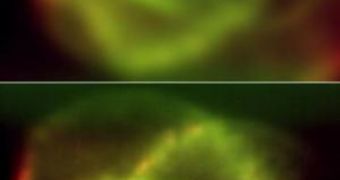A great obstacle has been overcome: for the first time, astronomers from the California Institute of Technology and the University of Cambridge have obtained detailed space pictures from Earth, using a new camera that delivers more accurate images of stars and nebulae than even the Hubble Space Telescope.
Pictures taken from ground-based telescopes have been always blurred by Earth's atmosphere, but the new technique, named adaptive optics (AO), fixed the blurring, but so far it has only functioned successfully in the infrared.
But the new noise-free, high-speed camera gets very high resolution imaging in visible light, recording partially fixed adaptive optics images at high speed (over 20 frames per second). A software then chooses the sharpest image.
Most are still blurred by the atmosphere, but some remain unaffected and their combination delivers the final high-resolution image, by means of a technique named "Lucky Imaging", as it is linked with the chance fluctuations in the atmosphere.
The project was finished at the 200-inch (5.1 m) Hale Telescope on Palomar Mountain. With a common technique, this telescope obtains images 10 times less detailed than those sent by the Hubble. With AO, it produced good infrared images, but until now, images in visible light were weaker than Hubble images.
The new pictures were two-times more detailed than those sent by the Hubble Space Telescope, being the sharpest space images ever taken in visible light either from the ground or from space!
"The system performed even better than we were expecting. It was fantastic to watch the first images come in and see that we were easily doing better than Hubble," said lead investigator Nicholas Law, a postdoctoral scholar at Caltech.
The new images of the globular star cluster M13, located 25,000 light years away, enabled the astronomers to detect stars as little as one light-day apart.
Stars in our neighborhood are much farther apart, the closest to the Sun system being located at more than four light-years away.
The researchers could also investigate better objects like the Cat's Eye Nebula (NGC 6543), eight times closer to earth than M13.
The new technique could also work in blue wavelengths. It could be improved in the future, with state-of-the-art deformable mirrors, sensors and a powerful laser and the new system could be available as early as in 2010.
"These Lucky Imaging results underscore the science potential of diffraction-limited visible-light observations on large ground-based telescopes," said Richard Dekany, Caltech's principal investigator for the new system.
For sharper pictures, also bigger telescopes are required, like the 10-meter Keck telescopes (on the top of Mauna Kea in Hawaii) or the Thirty Meter Telescope (TMT).

 14 DAY TRIAL //
14 DAY TRIAL //